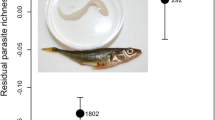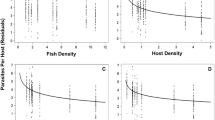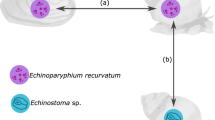Abstract
Within any parasite species, abundance varies spatially, reaching higher values in certain localities than in others, presumably reflecting the local availability of host resources or the local suitability of habitat characteristics for free-living stages. In the absence of strong interactions between two species of helminths with complex life cycles, we might predict that the degree to which their abundances covary spatially is determined by their common resource requirements, i.e. how many host species they share throughout their life cycles. We test this prediction using five trematode species, all with a typical three-host cycle, from multiple lake sampling sites in New Zealand’s South Island: Stegodexamene anguillae, Telogaster opisthorchis, Coitocaecum parvum, Maritrema poulini, and an Apatemon sp. Pairs of species from this set of five share the same host species at either one, two, or all three life cycle stages. Our results show that when two trematode species share the same host species at all three life stages, they show positive spatial covariation in abundance (of metacercarial and adult stages) across localities. When they share hosts at two life stages, they show positive spatial covariation in abundance in some cases but not others. Finally, if two trematode species share only one host species, at a single life stage, their abundances do not covary spatially. These findings indicate that the extent of resource sharing between parasite species can drive the spatial match-mismatch between their abundances, and thus influence their coevolutionary dynamics and the degree to which host populations suffer from additive or synergistic effects of multiple infections.


Similar content being viewed by others
References
Anderson RM, May RM (1978) Regulation and stability of host-parasite population interactions. I Regulatory processes. J Anim Ecol 47:219–247
Anderson RM, May RM (1979) Population biology of infectious diseases: part I. Nature 280:361–367
Arneberg P (2001) An ecological law and its macroecological consequences as revealed by studies of relationships between host densities and parasite prevalence. Ecography 24:352–358
Arneberg P, Skorping A, Grenfell BT, Read AF (1998) Host densities as determinants of abundance in parasite communities. Proc R Soc B 265:1283–1289
Blasco-Costa I, Poulin R (2013) Host traits explain the genetic structure of parasites: a meta-analysis. Parasitology 140:1316–1322
Blasco-Costa I, Rouco C, Poulin R (2015) Biogeography of parasitism in freshwater fish: spatial patterns in hot spots of infection. Ecography 38:301–310
Brown JH, Mehlman DW, Stevens GC (1995) Spatial variation in abundance. Ecology 76:2028–2043
Bush AO, Holmes JC (1986) Intestinal helminths of lesser scaup ducks: patterns of association. Can J Zool 64:132–141
Criscione CD, Blouin MS (2004) Life cycles shape parasite evolution: comparative population genetics of salmon trematodes. Evolution 58:198–202
Dezfuli BS, Giari L, De Biaggi S, Poulin R (2001) Associations and interactions among intestinal helminths of the brown trout, Salmo trutta, in northern Italy. J Helminthol 75:331–336
Diekmann O, Heesterbeek JAP (2000) Mathematical epidemiology of infectious diseases. Wiley, New York
Dobson AP (1985) The population dynamics of competition between parasites. Parasitology 91:317–347
Dobson AP, Roberts M (1994) The population dynamics of parasitic helminth communities. Parasitology 109:S97–S108
Esch GW, Kennedy CR, Bush AO, Aho JM (1988) Patterns in helminth communities in freshwater fish in Great Britain: alternative strategies for colonization. Parasitology 96:519–532
Ferguson KI, Stiling P (1996) Non-additive effects of multiple natural enemies on aphid populations. Oecologia 108:375–379
Haukisalmi V, Henttonen H (1993) Coexistence in helminths of the bank vole. Clethrionomys glareolus. I. Patterns of co-occurrence. J Anim Ecol 62:221–229
Hechinger RF, Lafferty KD, Kuris AM (2008) Trematodes indicate animal biodiversity in the Chilean intertidal and Lake Tanganyika. J Parasitol 94:966–968
Herrmann KK, Poulin R (2011) Encystment site affects the reproductive strategy of a progenetic trematode in its fish intermediate host: is host spawning an exit for parasite eggs? Parasitology 138:1183–1192
Holmstad PR, Skorping A (1998) Covariation of parasite intensities in willow ptarmigan, Lagopus lagopus L. Can J Zool 76:1581–1588
Kennedy CR, Bush AO, Aho JM (1986) Patterns in helminth communities: why are birds and fish so different? Parasitology 93:205–215
Lagrue C, Poulin R (2015) Bottom-up regulation of parasite population densities in freshwater ecosystems. Oikos. doi:10.1111/oik.02164
Lagrue C, Poulin R, Cohen JE (2015) Parasitism alters three power laws of scaling in a metazoan community: Taylor’s law, density-mass allometry, and variance-mass allometry. Proc Natl Acad Sci U S A 112:1791–1796
Lotz JM, Font WF (1991) The role of positive and negative interspecific associations in the organization of communities of intestinal helminths of bats. Parasitology 103:127–138
May RM, Anderson RM (1979) Population biology of infectious diseases: part II. Nature 280:455–461
Perez-del-Olmo A, Morand S, Raga JA, Kostadinova A (2011) Abundance-variance and abundance-occupancy relationships in a marine host-parasite system: the importance of taxonomy and ecology of transmission. Int J Parasitol 41:11361–1370
Poulin R (2001) Interactions between species and the structure of helminth communities. Parasitology 122:S3–S11
Poulin R (2006) Variation in infection parameters among populations within parasite species: intrinsic properties versus local factors. Int J Parasitol 36:877–885
Poulin R, Dick TA (2007) Spatial variation in population density across the geographical range in helminth parasites of yellow perch Perca flavescens. Ecography 30:629–636
Rauque CA, Paterson RA, Poulin R, Tompkins DM (2011) Do different parasite species interact in their effects on host fitness? A case study on parasites of the amphipod Paracalliope fluviatilis. Parasitology 138:1176–1182
Sonnenholzner JI, Lafferty KD, Ladah LB (2011) Food webs and fishing affect parasitism of the sea urchin Eucidaris galapagensis in the Galápagos. Ecology 92:2276–2284
Thieltges DW, Hof C, Borregaard MK, Dehling DM, Brändle M, Brandl R, Poulin R (2011) Range size patterns in European freshwater trematodes. Ecography 34:982–989
Thompson JN (2005) The geographic mosaic of coevolution. University of Chicago Press, Chicago
Acknowledgments
We thank Anne Besson, Isa Blasco-Costa, Manna Warburton, and Kim Garrett for assistance with field collection and laboratory processing of samples. We also thank an anonymous reviewer for constructive comments on an earlier version of the manuscript. This study was funded by a grant from the Marsden Fund (New Zealand) to RP.
Compliance statement
Animal collections and the protocol for this study were approved by Otago University’s Animal Ethic Committee (permit 10/12), New Zealand’s Department of Conservation (permit OT-34204-RES), and by Fish and Game New Zealand.
Author information
Authors and Affiliations
Corresponding author
Rights and permissions
About this article
Cite this article
Lagrue, C., Poulin, R. Spatial covariation of local abundance among different parasite species: the effect of shared hosts. Parasitol Res 114, 3637–3643 (2015). https://doi.org/10.1007/s00436-015-4590-0
Received:
Accepted:
Published:
Issue Date:
DOI: https://doi.org/10.1007/s00436-015-4590-0




